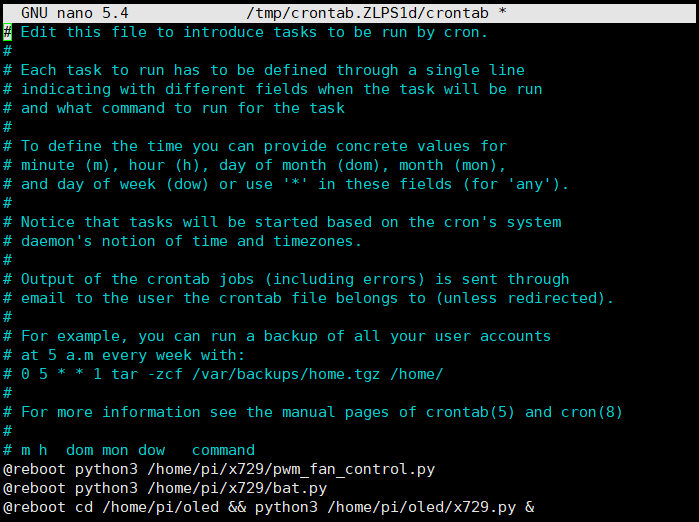Difference between revisions of "How to enable OLED display"
Jump to navigation
Jump to search
| Line 22: | Line 22: | ||
3. Installation | 3. Installation | ||
| + | 3.1 Download the required scripts | ||
| + | pi@raspberrypi ~ $ git clone https://github.com/suptronics/oled.git | ||
cd ~ | cd ~ | ||
cd oled | cd oled | ||
| − | 3. | + | 3.3 Install the Adafruit CircuitPython library |
pi@raspberrypi:~/oled $ sudo python3 raspi-blinka.py | pi@raspberrypi:~/oled $ sudo python3 raspi-blinka.py | ||
| − | 3. | + | 3.4 Answering Y and hitting Enter when reboot prompted. Then renavigate to the oled directly by entering: |
pi@raspberrypi ~ $ cd oled | pi@raspberrypi ~ $ cd oled | ||
| − | 3. | + | 3.4 Run the script to test the display |
pi@raspberrypi:~/oled $ sudo python3 x729.py | pi@raspberrypi:~/oled $ sudo python3 x729.py | ||
| − | 3. | + | 3.5 Run the script at Raspberry Pi boot |
pi@raspberrypi:~/oled $ sudo crontab -e | pi@raspberrypi:~/oled $ sudo crontab -e | ||
| − | 3. | + | 3.6 Add a line at the end of the file that reads like this: |
@reboot cd /home/pi/oled && python3 /home/pi/oled/x729.py & | @reboot cd /home/pi/oled && python3 /home/pi/oled/x729.py & | ||
[[File:X729-9.png|none]] | [[File:X729-9.png|none]] | ||
Revision as of 18:17, 19 November 2022
How to enable OLED display on Raspbian:
1. Update your Pi and Install the required dependencies
sudo apt-get update sudo apt-get -y upgrade sudo apt-get -y install i2c-tools python3-smbus python-smbus sudo apt-get -y install python3-pip python3-pil sudo pip3 install --upgrade setuptools sudo pip3 install --upgrade adafruit-python-shell sudo pip3 install adafruit-circuitpython-ssd1306 sudo pip3 install pi-ina219 sudo pip3 show pi-ina219
2. Run the following command to check the oled i2c port
sudo i2cdetect -y 1
for X729, the I2C address is 0x3c
3. Installation
3.1 Download the required scripts
pi@raspberrypi ~ $ git clone https://github.com/suptronics/oled.git cd ~ cd oled
3.3 Install the Adafruit CircuitPython library
pi@raspberrypi:~/oled $ sudo python3 raspi-blinka.py
3.4 Answering Y and hitting Enter when reboot prompted. Then renavigate to the oled directly by entering:
pi@raspberrypi ~ $ cd oled
3.4 Run the script to test the display
pi@raspberrypi:~/oled $ sudo python3 x729.py
3.5 Run the script at Raspberry Pi boot
pi@raspberrypi:~/oled $ sudo crontab -e
3.6 Add a line at the end of the file that reads like this:
@reboot cd /home/pi/oled && python3 /home/pi/oled/x729.py &
Save and exit. In nano, you do that by hitting CTRL + X, answering Y and hitting Enter when prompted.

Enable comment auto-refresher
Anonymous user #1
Permalink |
Harry